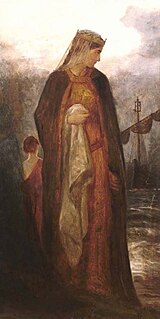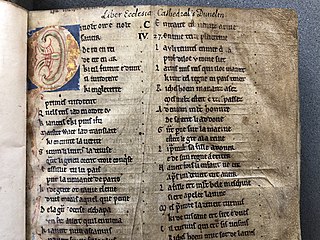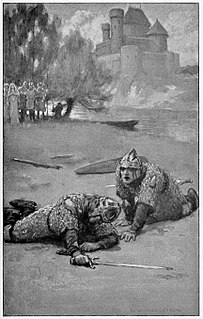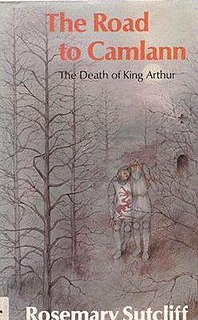
King Arthur was a legendary British leader who, according to medieval histories and romances, led the defence of Britain against Saxon invaders in the late 5th and early 6th centuries. The details of Arthur's story are mainly composed of folklore and literary invention, and modern historians generally agree that he is unhistorical. The sparse historical background of Arthur is gleaned from various sources, including the Annales Cambriae, the Historia Brittonum, and the writings of Gildas. Arthur's name also occurs in early poetic sources such as Y Gododdin.

The Round Table is King Arthur's famed table in the Arthurian legend, around which he and his knights congregate. As its name suggests, it has no head, implying that everyone who sits there has equal status. The table was first described in 1155 by Wace, who relied on previous depictions of Arthur's fabulous retinue. The symbolism of the Round Table developed over time; by the close of the 12th century it had come to represent the chivalric order associated with Arthur's court, the Knights of the Round Table.

Guinevere, often written as Guenevere or Guenever, is the wife and queen of King Arthur in the Arthurian legend. Guinevere has been portrayed as everything from a villainous and opportunistic traitor to a fatally flawed but noble and virtuous lady. She has first appeared in Geoffrey of Monmouth's Historia Regum Britanniae, a pseudo-historical chronicle of British history written in the early 12th century, and continues to be a popular character in the modern adaptations of the legend.

Lancelot du Lac, also written as Launcelot and other spellings, is one of the Knights of the Round Table in the Arthurian legend where he typically figures as King Arthur's greatest companion and one of his greatest knights. In the best-known tradition, Lancelot is the orphaned son of King Ban of Benwick, raised in a fairy realm by the Lady of the Lake. He then becomes the lord of Joyous Gard, and the greatest swordsman and jouster as the knight of most martial prowess of the age – until his adulterous affair with Queen Guinevere is discovered, causing a civil war which is exploited by Mordred and brings about the end of Arthur's kingdom.

Mordred or Modred is a character who is variously portrayed in the Arthurian legend. The earliest known mention of a possibly historical Medraut is in the Welsh chronicle Annales Cambriae, wherein he and Arthur are ambiguously associated with the Battle of Camlann in a brief entry for the year 537. His figure seemed to have been regarded positively in the early Welsh tradition and may have been related to that of Arthur's son.

Le Morte d'Arthur is a 15th-century Middle English prose reworking by Sir Thomas Malory of tales about the legendary King Arthur, Guinevere, Lancelot, Merlin and the Knights of the Round Table—along with their respective folklore. In order to tell a "complete" story of Arthur from his conception to his death, Malory compiled, rearranged, interpreted and modified material from various French and English sources. Today, this is one of the best-known works of Arthurian literature. Many authors since the 19th-century revival of the legend have used Malory as their principal source.
King Leodegrance, sometimes Leondegrance, Leodogran, or variations thereof, is the father of Queen Guinevere in Arthurian legend. His kingdom of Cameliard is usually identified with Cornwall but may be located in Breton Cornouaille near the town of Carhaix-Plouguer, which is the Carhaise of L'Histoire de Merlin.
Maleagant is a villain from Arthurian legend. In a number of versions of a popular episode, Maleagant abducts King Arthur’s wife, Queen Guinevere, necessitating her rescue by Arthur and his knights. The earliest surviving version of this episode names the abductor Melwas; as Maleagant, he debuts in Chrétien de Troyes' French romance Lancelot, the Knight of the Cart. However, all surviving versions seem to be later adaptations of a stock narrative of significantly earlier provenance.

The Brut or Roman de Brut by the poet Wace, is a loose and expanded translation in almost 15,000 lines of Norman-French verse of Geoffrey of Monmouth's Latin History of the Kings of Britain. It was formerly known as the Brut d'Engleterre or Roman des Rois d'Angleterre, though Wace's own name for it was the Geste des Bretons, or Deeds of the Britons. Its genre is equivocal, being more than a chronicle but not quite a fully-fledged romance. It narrates a largely fictional version of Britain's story from its settlement by Brutus, a refugee from Troy, who gives the poem its name, through a thousand years of pseudohistory, including the story of king Leir, up to the Roman conquest, the introduction of Christianity, and the legends of sub-Roman Britain, ending with the reign of the 7th-century king Cadwallader. Especially prominent is its account of the life of King Arthur, the first in any vernacular language, which instigated and influenced a whole school of French Arthurian romances dealing with the Round Table – here making its first appearance in literature – and with the adventures of its various knights.

Sir Balin le Savage, also known as the Knight with the Two Swords, is a character in the Arthurian legend. Like Sir Galahad, Sir Balin is a late addition to the medieval Arthurian world. His story, as told by Thomas Malory in Le Morte d'Arthur, is based upon that told in the continuation of the second book of the Post-Vulgate cycle of legend, the Suite du Merlin.

King Arthur and the Knights of the Round Table is a Japanese anime series based on Arthurian legend. Produced by Toei Animation, the series consists of 30 half-hour episodes released between 9 September 1979 and 3 March 1980. The series achieved great popularity in its non-English translations.
Bedegraine is a location featured in some tellings of the Arthurian legend. Its chief importance is as the site of a battle where King Arthur solidifies his reign in a victory over rebel kings.

Queen of Camelot is an Arthurian-legend based novel shown through the viewpoint of Queen Guinevere. It is a combination of two of Nancy McKenzie's previous books The Child Queen and The High Queen. She states in the foreword that she originally intended the novels to be combined, but they were split at the time of publication because of their length.
King Arthur's messianic return is an aspect of the legend of King Arthur, the mythical 6th-century British king. Few historical records of Arthur remain, and there are doubts that he ever existed, but he achieved a mythological stature that gave rise to a growing literature about his life and deeds. One recurrent aspect of Arthurian literature was the notion that he would one day return in the role of a messiah to save his people.

Guinevere: The Legend of Autumn is a 1993 novel by Persia Woolley. It is the third book of the Guinevere trilogy. The novel relates the events of the Arthurian legend in first-person perspective from the point of view of Guinevere, the wife of King Arthur. Beginning with Guinevere reflecting while imprisoned before being burnt at the stake for her affair with Lancelot, Guinevere retells the quest of the Holy Grail, the coming of Perceval and Gareth to the court and Mordred's rebellion with his brothers Agravain and Gaheris. The novel finishes with Arthur's war with Lancelot over Guinevere and the war between Arthur and his son Mordred ending in the death of Arthur and the end of an age.

The Road to Camlann: The Death of King Arthur is the third book in Rosemary Sutcliff's Arthurian trilogy, after The Sword and the Circle and The Light Beyond the Forest. This book portrays the events that lead to the Battle of Camlann and the downfall of Camelot, including Guinevere and Lancelot's secret affair, and the betrayal of Arthur's illegitimate son Mordred.
Nancy Affleck McKenzie is an American author of historical fiction. Her primary focus is Arthurian legend.

The Story of King Arthur and His Knights is a 1903 novel by the American illustrator and writer Howard Pyle. The book contains a compilation of various stories, adapted by Pyle, regarding the legendary King Arthur of Britain and select Knights of the Round Table. Pyle would go on to write other stories concerning King Arthur and his knights, including The Story of the Champions of the Round Table, The Story of Sir Launcelot and His Companions, and The Story of the Grail and the Passing of King Arthur.
Guiomar is the best known name of a character appearing in many medieval texts relating to the Arthurian legend, often in relationship with Morgan le Fay or a similar fairy queen type character.
Norma Therese Falby (1917-2006) — pen name “Norma Lorre Goodrich” — was a professor of French, comparative literature and writing who taught in the University of Southern California and Claremont Colleges for 45 years and published several popular books on Arthuriana.












